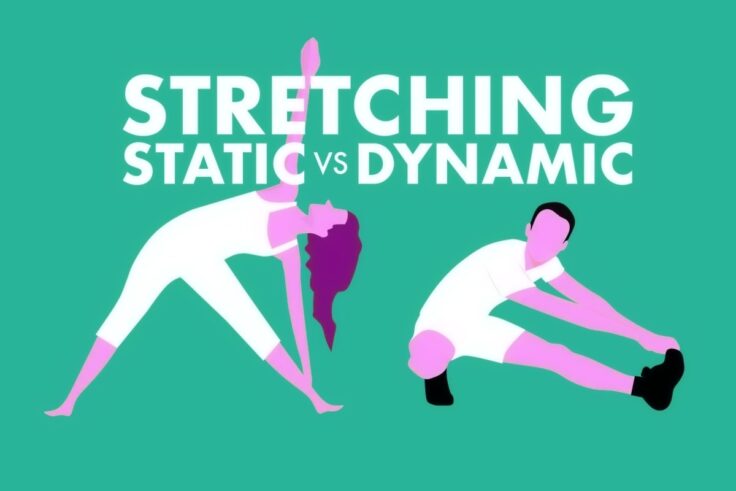Pros And Cons Of Static And Dynamic Stretching

Whatever type of stretching you choose, both static and dynamic stretching will help boost your overall health and athletic performance.
Stretching is an important part of any exercise routine, as it can help to improve flexibility, reduce the risk of injury, and increase muscle range of motion.
But not all stretches are created equal; there is a difference between static and dynamic stretching.
Static stretching involves holding a stretch for an extended period, while dynamic stretching requires active movement through the full range of motion.
Each type has advantages and disadvantages that should be considered when developing your workout program.
So, let’s explore the pros and cons of static and dynamic stretching so you can decide which works best for you.
What Is Static Stretching?
Static stretching is a common practice used by athletes and exercise enthusiasts to improve their flexibility and reduce the risk of injury.
Holding a single position for an extended period allows muscles to be lengthened, and pain can be relieved. Static stretching also helps to prevent muscle strains, tendonitis, fasciitis, and back pain.
While it may not provide a direct physical benefit other than increased flexibility, many people find the relaxation aspect of static stretching helpful, allowing them to focus better during their workout or competition.
Static stretching can benefit everyone; moderate to advanced fitness levels should still include different forms of dynamic stretching before any intense activity.

Advantages Of Static Stretching
Static stretching offers numerous advantages that can benefit both beginners and experienced athletes.
This stretching helps increase flexibility, reduce soreness after a workout, and improve one’s range of motion, resulting in improved posture and movement.
Other benefits associated with static stretching include decreased stress levels, improved circulation, and improved well-being.
The key to reaping these advantages is to stick with a consistent stretching regimen over time. Regularly taking the time for some static stretching can make all the difference when it comes to reaching individual fitness goals.
Disadvantages Of Static Stretching
Static stretching can be an effective way to warm up the body. However, there are some potential disadvantages to this type of stretching.
First, static stretches typically involve prolonged stretches, so they can strain joints and muscles if not done properly. This could potentially lead to injury or pain in the long run.
Additionally, while static stretches can improve flexibility and range of motion, if done incorrectly, they may reduce muscle strength and power because they leave the muscles tired due to the elongation of the fibers.
Finally, static stretching is not always the best for those who do more intense physical activities such as running or weight lifting, as it does not raise body temperature sufficiently enough for optimal performance.
What Is Dynamic Stretching?
Dynamic stretching is a form of physical exercise that involves active movement and motion to improve muscle elasticity, range of motion, and joint mobility. It is an effective way to train muscles as it activates them before physical activity.
This is advantageous to athletes or those engaging in high-intensity activities, as the repetitive movements warm up their bodies and reduce their risk of injury due to sudden movements or lack of flexibility.
Dynamic stretching typically consists of controlled leg swings, arm swings, and torso twists that prepare the body for more strenuous activities.
The movements are typically slow, steady, and systematic, causing beneficial changes to the muscles, joints, and ligaments being targeted.
When performed correctly, dynamic stretching can help increase performance during any exercise.

Advantages Of Dynamic Stretching
The main advantage of dynamic stretching lies in its improved flexibility. When executed correctly, it increases the range of motion in the joints, helping to enhance both athletic and everyday performance.
Dynamic stretches can also reduce muscle soreness and increase blood flow which helps speed up muscle recovery after a workout or sporting activity.
Furthermore, this type of stretching can help build balance because exercises focus on both sides of the body and require stability for coordination and control.
Suppose you desire to increase your physical endurance. In that case, dynamic stretching is ideal as it strengthens the muscles used during physical activities while improving ligament elasticity that can protect against future injuries.
Disadvantages Of Dynamic Stretching
Dynamic stretching can present several disadvantages if done improperly. First, dynamic stretches must be performed slowly and controlled, or the risk of injury rises drastically.
Many joint injuries are brought about due to performing dynamic stretches too quickly or carelessly, potentially harming a person’s body.
Additionally, there is also a risk that dynamic stretching will hinder coordination due to its lack of emphasizing static movement assurance. This means an athlete could fail to properly acquire the same motions over and over again if they aren’t careful enough when executing these exercises.
As such, dynamic stretching should be used judiciously by any athlete looking to maximize their performance since even the slightest wrong move can set one back significantly.
Static Or Dynamic Stretching: Which Is Best For You?
Whether static or dynamic stretching is best depends on your individual goals.
As a general rule, static stretching should be enough to get the job done if you want to improve flexibility and range of motion.
On the other hand, dynamic stretching could provide more comprehensive benefits if you’re trying to increase strength and endurance.
Ultimately, the decision lies in your hands – whatever type of stretching you choose should be tailored to your specific needs and goals.
No matter which type of stretching you decide on, static and dynamic stretching have been proven beneficial for physical health and performance. By taking the time to understand their differences and pros and cons, you can decide which is best for you.